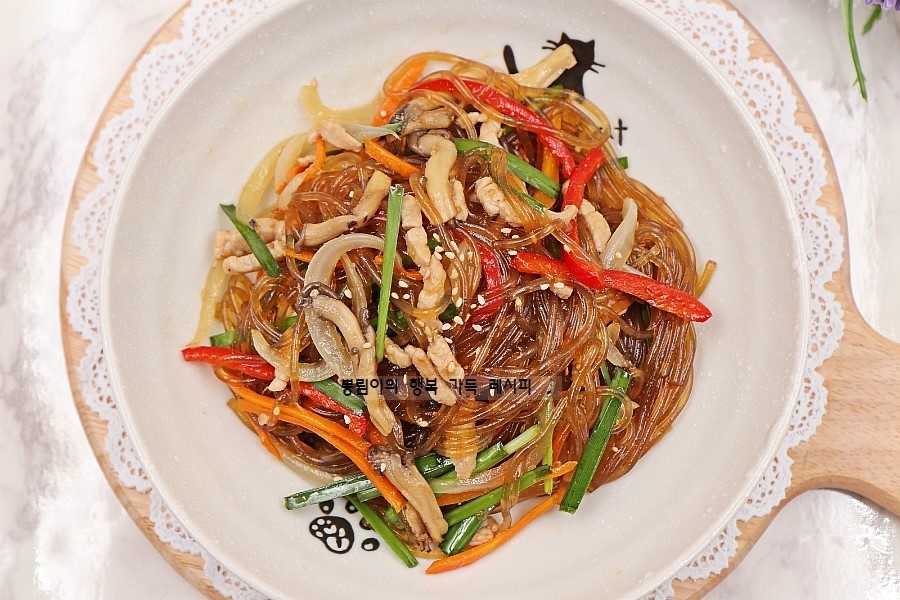Delicious Japchae Made with the Golden Recipe
Japchae Golden Recipe from Saengsaeng Information: The Best Way to Make Japchae Revealed!

Tonight’s dinner table is graced with the special Japchae golden recipe revealed on Saengsaeng Information. Enjoy a unique Japchae dish, boasting a variety of textures and flavors from the harmonious blend of vegetables and meat.
Main Ingredients- Glass noodles (Japchae noodles) 2 handfuls (approx. 200g)
- 1/2 Onion
- 70g Oyster mushrooms (or similar)
- 60g Carrot
- 80g Bell pepper (use various colors for visual appeal)
- 50g Chives
- 250g Pork for Japchae
- 2-3 Tbsp Sesame oil
- 1-2 Tbsp Toasted sesame seeds
Pork Marinade Ingredients- Pinch of salt
- 1 Tbsp Mirin (rice wine)
- Pinch of black pepper
Japchae Sauce Ingredients- 13-14 Tbsp Soy sauce (for soup/seasoning)
- 10 Tbsp Oligosaccharide (or corn syrup)
- 4 Tbsp Sugar (adjust to taste)
- Pinch of salt
- 1 Tbsp Mirin (rice wine)
- Pinch of black pepper
Japchae Sauce Ingredients- 13-14 Tbsp Soy sauce (for soup/seasoning)
- 10 Tbsp Oligosaccharide (or corn syrup)
- 4 Tbsp Sugar (adjust to taste)
Cooking Instructions
Step 1
[Prepare and Slice Vegetables] It’s time to prepare the fresh vegetables that will make your Japchae look and taste amazing. Wash the bell peppers, carrots, and onions thoroughly, then slice them into thin, long strips. Slicing them this way ensures they blend beautifully when cooked. 
Step 2
Cut the chives into about 5cm lengths. Tear the oyster mushrooms into bite-sized pieces along the grain. Tearing the mushrooms helps them absorb the sauce better, enhancing their flavor.

Step 3
[Marinate the Pork] In a bowl, combine the 250g of pork for Japchae with 1 Tbsp of mirin to remove any gamey odors. Add a pinch of salt and a pinch of black pepper. Gently mix and knead, then let it marinate for about 10 minutes. Marinating the pork beforehand will make it more tender and delicious.
Step 4
[Boil the Glass Noodles] In a large pot of boiling water, add two handfuls (approx. 200g) of glass noodles and cook for about 10 minutes. Be careful not to overcook them, as they can become mushy. Once cooked, rinse the noodles thoroughly under cold running water to remove excess starch. Drain them well in a colander. Ensuring the noodles are well-drained is key for them to absorb the sauce properly. 
Step 5
[Stir-fry Vegetables Separately] Heat a little cooking oil in a pan. Stir-fry the sliced onions, carrots, bell peppers, and torn oyster mushrooms separately. (Save the chives for later.) Season each vegetable with a tiny pinch of salt as you stir-fry. This enhances their natural sweetness and adds a subtle seasoning that makes them much tastier. Stir-frying them individually helps maintain their texture and vibrant colors. 
Step 6
[Stir-fry the Pork] Add a little cooking oil to a pan and stir-fry the marinated pork. Make sure to cook it thoroughly until it’s completely done inside. You can test this by piercing it with a fork; there should be no pink meat visible. Once cooked, set the pork aside. 
Step 7
[Simmer Noodles in Sauce] Now, it’s time to cook the heart of the Japchae: the noodles and sauce. In a pan, combine 13-14 Tbsp soy sauce, 10 Tbsp oligosaccharide, and 4 Tbsp sugar. Once the mixture comes to a boil, add the boiled glass noodles. Add 4 Tbsp of canola oil at this stage to prevent the noodles from sticking together and to give them a beautiful sheen. Tip: The basic ratio is 1 part soy sauce to 2 parts oligosaccharide, but you can substitute sugar if you run out of oligosaccharide. However, be mindful that sugar is sweeter than oligosaccharide, so you might need to use less. 
Step 8
Continue to stir-fry the noodles over medium heat until the sauce has reduced and coats the noodles evenly. Once the noodles have absorbed the delicious sauce and are slightly thickened, turn off the heat and let them cool slightly. Simmering the noodles in the sauce first creates a deeper, richer flavor.

Step 9
[Combine All Ingredients] Add the stir-fried vegetables and cooked pork to the sauce-simmered noodles. Gently toss everything together. Finally, drizzle in 2-3 Tbsp of sesame oil and 1-2 Tbsp of toasted sesame seeds, and mix well until everything is evenly combined. Your delicious and visually appealing Japchae is ready to serve! The sesame oil and seeds add a wonderful nutty aroma and flavor. 
Step 10
Typically, Japchae is made by mixing cooked ingredients and sauce with boiled noodles. However, this golden recipe, which involves simmering the noodles first in the sauce, not only makes the dish look more appetizing but also results in a much deeper flavor as the sauce penetrates the noodles thoroughly. This was my first time trying this method, and I was incredibly satisfied!
Step 11
You know how honest children’s taste buds are – they won’t eat food that isn’t delicious! But with this Saengsaeng Information golden recipe Japchae, they devoured it so enthusiastically, calling it incredibly tasty. Delicious food truly makes everyone happy.
Step 12
From now on, I plan to stick to this Saengsaeng Information Japchae golden recipe whenever I make Japchae! This method of making delicious Japchae really seems to be the best secret. I highly recommend you all try it too! (+_+)


